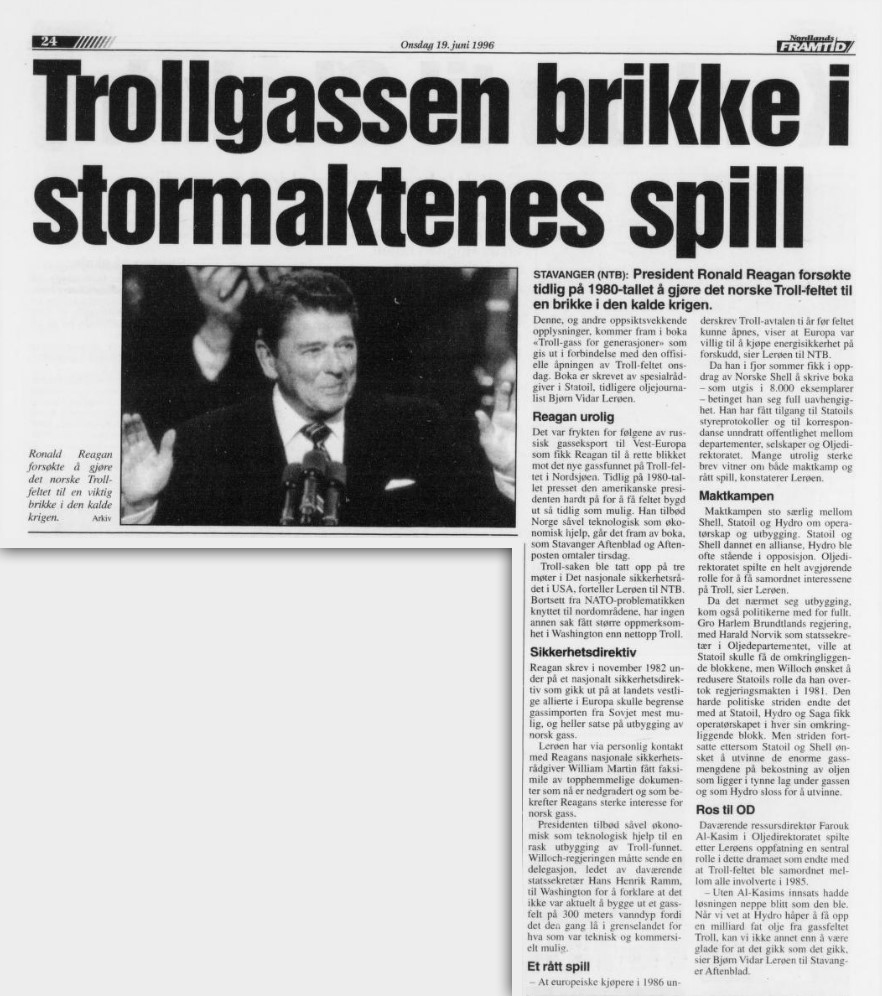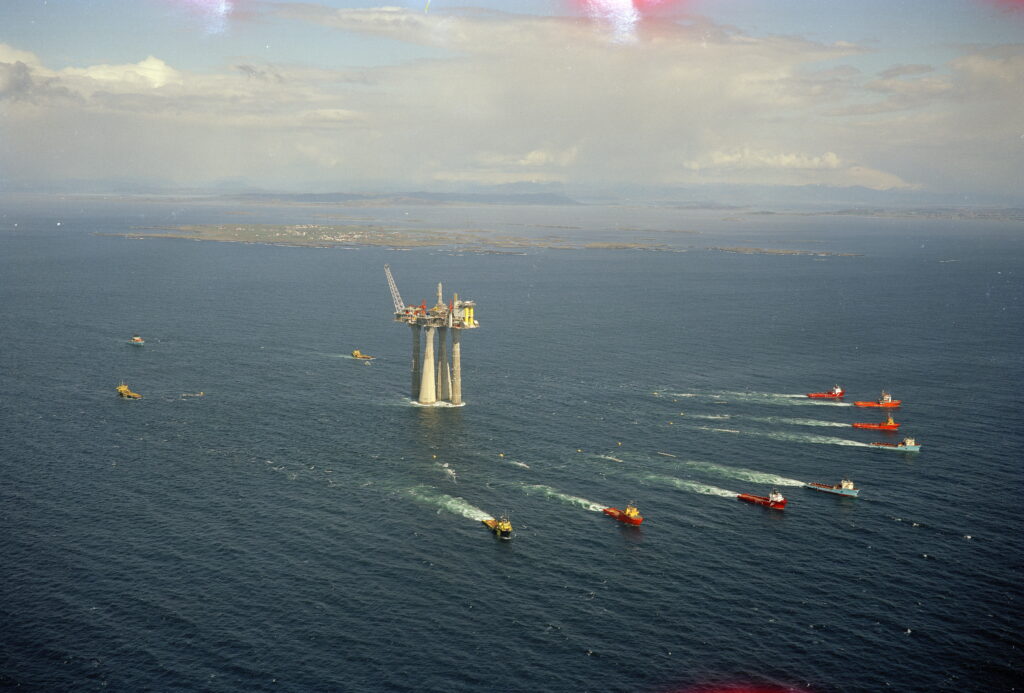Americans look to Norwegian gas

In the early 1980s, the west European nations had lost much of their confidence in the stability of oil supplies from Middle Eastern exporters. The 1973 oil crisis, the Iranian revolution in 1979 and the Iran-Iraq war had prompted many to look around for alternative energy suppliers.
As a result, the “energy agreement of the century” was signed in 1981 between the Soviet Union and several west European nations – to the dismay of the Americans. That was not only because it gave the USSR much-needed hard currency earnings, but also because it increased Europe’s strategic dependence on its superpower neighbour to the east. It did not help matters that the contract was entered into at a time when US-Soviet relations were very poor – in part because of the USSR’s invasion of Afghanistan in 1979.[REMOVE]Fotnote: One consequence was an American boycott of the 1980 summer Olympics in Moscow, with the Soviets retaliating in Los Angeles four years later.
Great attention
Against that international political background, exploration drilling on the Norwegian continental shelf (NCS) in 1979 yielded a discovery which attracted great attention. Proving a giant gas zone over an oil zone, this well was characterised by the Norwegian Petroleum Directorate (NPD) as “the biggest encouragement” of the year.[REMOVE]Fotnote: Annual report, 1979, Norwegian Petroleum Directorate: 22 (f). Even at such an early stage, the NPD could state with reasonable certainty that the gas was recoverable and that possible oil reserves in place could be considerable.[REMOVE]Fotnote: Ibid: 44.
This forecast would prove correct, but the NPD also predicted considerable challenges in exploiting the resources. First, the oil primarily needed to be produced before the gas.[REMOVE]Fotnote: Ibid: 44-45. Second, the field – which was named Troll – lay in deep water at around 300 metres.
These and other difficulties would become elements in a complex interaction between US energy strategy and Norwegian domestic politics.[REMOVE]Fotnote: Aarab, Walied Færevik, 2018, Geopolitical and Commercial Aspects of Troll Gas (1981-1983): Norway’s Increased Significance in European Energy Security, master’s thesis in history, University of Oslo. https://www.duo.uio.no/bitstream/handle/10852/63061/Geopolitical-and-Commercial-Aspects-of-Troll-Gas–1981-1983-revised.pdf?sequence=8&isAllowed=y.

As if US-USSR relations were not chilly enough already, a conservative Republic administration took power in 1981 under president Ronald Reagan and stepped up the anti-Soviet rhetoric. Forces in this administration were eager to see a faster pace of development for Norwegian gas reserves, above all Troll, in order to weaken the enemy to the east. The issue was sufficiently important to be considered several times by the US National Security Council (NSC).[REMOVE]Fotnote: Lerøen, Bjørn Vidar, 2002, Drops of black gold. Statoil 1972-2002, Statoil: 194. One instance was an NSC directive of 16 November 1982, which highlighted the importance of “accelerated development of alternative western energy resources, principally Norwegian gas reserves”.[REMOVE]Fotnote: National security decision, directive number 66, 16 November 1982, facsimile in Lerøen, Bjørn Vidar, 1996, Troll. Gas for generations, Shell: 79.
This energy strategy on the part of Norway’s most important ally challenged aspects of domestic Norwegian policies.
Hard to go faster
The Norwegian government took the view that the process leading up to possible gas exports from Troll to west European buyers was difficult to speed up because of the water depths involved.
Senior representatives from Norway were dispatched to Washington DC in 1982, in part to explain the technical challenges faced. Hans Henrik Ramm, then state secretary (junior minister) at the Ministry of Petroleum and Energy, made use of the tools he had to hand give a lecture on these problems at a meeting.
He deployed three glasses on the table to represent the shafts of a proposed Troll gas platform. Each was as tall as the Empire State Building and filled with equipment. They would also have a factory on top – Ramm added a fourth glass to show that. In addition, this gigantic structure had to be towed out and placed on the seabed in a depth of about 300 metres. Ramm observed: “Such a project would have taken its time even for American industry.”[REMOVE]Fotnote: Aarab, Walied Færevik, op.cit: 97.
The Norwegian government, with the NPD in the lead, also had to assess how Troll could be exploited to the greatest socio-economic benefit for Norway. Given the size of the reserves, the combination of oil and gas, and pressure communication between several NCS blocks with different licensees, this was a complicated and lengthy process.[REMOVE]Fotnote: Statoil ultimately became operator for gas production, which Norsk Hydro was to produce the underlying oil.
An important question for Norway was also how large a market share could realistically be achieved in supplying west European gas customers. Another consideration was the prospects for reasonably stable gas prices which could justify not only a development but also speeding it up in the way the Americans wanted. With energy prices on the way down, the final conclusion was that forcing projects ahead would be undesirable in view of the unfavourable market conditions.[REMOVE]Fotnote: Aarab, Walied Færevik, op.cit: 87.
The process therefore moved forward with the Norwegians in the driving seat and at their pace. Although it took time, agreement on selling Troll gas was reached in 1986 with European customers. Deliveries were due to begin in 1996. This ranked as the biggest export agreement in Norway’s history.[REMOVE]Fotnote: Borchgrevink, Aage Storm, 2019. Giganten. Det norske oljeeventyret, Statoil-Equinor. Kagge: 172. See also Johnsen, Arve, 1990, Statoil-år. Gjennombrudd og vekst. 1978-1987, Gyldendal: 258-265. The negotiations were led on the Norwegian side by Statoil CEO Arve Johnsen.

The Troll A platform was towed out to the field in 1995 as the world’s tallest-ever floating structure with a height of 472 metres. That was 13 years after Ramm’s explanation to the American authorities.
This history demonstrates that the process from exploration to development and gas sales cannot be implemented with the wave of a hand, even under substantial pressure from a powerfully ally.[REMOVE]Fotnote: Historian Gunnar Nerheim has defined the difference in transport and sales terms between oil and gas in this way: “Shipping and selling crude oil are easy. The gas market is far more rigid. Once the pipelines have been laid, buyer and seller are more or less stuck with each other. Long-term binding agreements must be entered into which mean that the seller, and not least the banks, who are to fund the development must make a return on the investment. For their part, the buyers want assurances that the gas to be distributed to their customers will be delivered when agreed and in the right quantity.” Nerheim, Gunnar, 1996. En gassnasjon blir til, vol 2, Norsk oljehistorie, Norwegian Petroleum Society, Leseselskapet: 283.
Despite all the challenges, the process survived by a good margin one of the superpowers of the day. By the time gas deliveries from Troll to Europe began, the Soviet Union had become history. However, the Russian attack on Ukraine in 2022 could open a new chapter in Troll’s history and give it a renewed strategic significance for European and American energy policy.
arrow_backDiving on StatpipeDisputing the Statfjord operatorshiparrow_forward